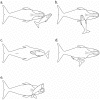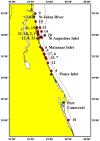Swim speed, behavior, and movement of North Atlantic right whales (Eubalaena glacialis) in coastal waters of northeastern Florida, USA
- PMID: 23326603
- PMCID: PMC3542314
- DOI: 10.1371/journal.pone.0054340
Swim speed, behavior, and movement of North Atlantic right whales (Eubalaena glacialis) in coastal waters of northeastern Florida, USA
Abstract
In a portion of the coastal waters of northeastern Florida, North Atlantic right whales (Eubalaena glacialis) occur close to shore from December through March. These waters are included within the designated critical habitat for right whales. Data on swim speed, behavior, and direction of movement--with photo-identification of individual whales--were gathered by a volunteer sighting network working alongside experienced scientists and supplemented by aerial observations. In seven years (2001-2007), 109 tracking periods or "follows" were conducted on right whales during 600 hours of observation from shore-based observers. The whales were categorized as mother-calf pairs, singles and non-mother-calf pairs, and groups of 3 or more individuals. Sample size and amount of information obtained was largest for mother-calf pairs. Swim speeds varied within and across observation periods, individuals, and categories. One category, singles and non mother-calf pairs, was significantly different from the other two--and had the largest variability and the fastest swim speeds. Median swim speed for all categories was 1.3 km/h (0.7 kn), with examples that suggest swim speeds differ between within-habitat movement and migration-mode travel. Within-habitat right whales often travel back-and-forth in a north-south, along-coast, direction, which may cause an individual to pass by a given point on several occasions, potentially increasing anthropogenic risk exposure (e.g., vessel collision, fishing gear entanglement, harassment). At times, mothers and calves engaged in lengthy stationary periods (up to 7.5 h) that included rest, nursing, and play. These mother-calf interactions have implications for communication, learning, and survival. Overall, these behaviors are relevant to population status, distribution, calving success, correlation to environmental parameters, survey efficacy, and human-impacts mitigation. These observations contribute important parameters to conservation biology, predictive modeling, and management. However, while we often search for predictions, patterns, and means, the message here is also about variability and the behavioral characteristics of individual whales.
Conflict of interest statement
Figures





Comment on
-
Clinic-integrated behavioral intervention for families of youth with type 1 diabetes: randomized clinical trial.Pediatrics. 2012 Apr;129(4):e866-73. doi: 10.1542/peds.2011-2858. Epub 2012 Mar 5. Pediatrics. 2012. PMID: 22392172 Free PMC article. Clinical Trial.
References
-
- Moore JC (1953) Distribution of marine mammals to Florida waters. American Midland Naturalist 49: 117–158.
-
- Layne JN (1965) Observations on marine mammals in Florida waters. Bulletin of the Florida State Museum 9: 132–181.
-
- Caldwell DK, Golley FB (1965) Marine mammals from the coast of Georgia to Cape Hatteras. Journal of the Elisha Mitchell Society 81: 24–32.
-
- Caldwell DK, Caldwell MC (1972) The World of the Bottlenosed Dolphin. Philadelphia, Pennsylvania: J.B. Lippincott. 157 p.
-
- Winn HE (1984) Development of a right whale sighting network in the southeastern U.S. Report No. MMC-82/05 to the Marine Mammal Commission. Available as: Document PB84-240548, National Technical Information Service, Springfield, Virginia. 16 p.
Publication types
MeSH terms
LinkOut - more resources
Full Text Sources
Other Literature Sources

